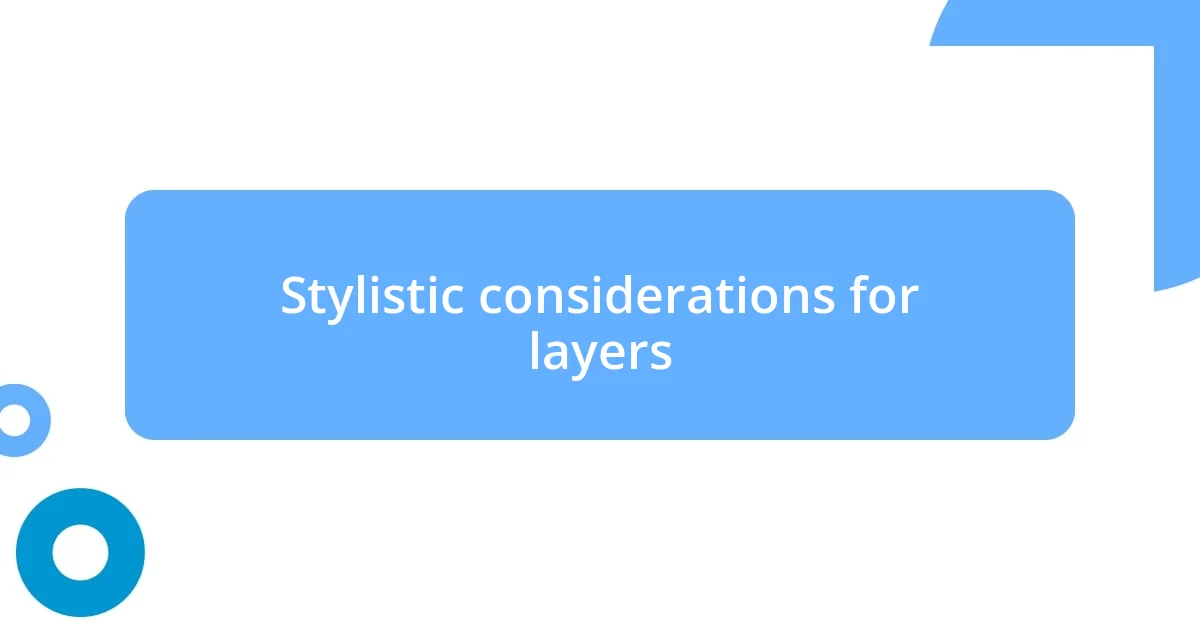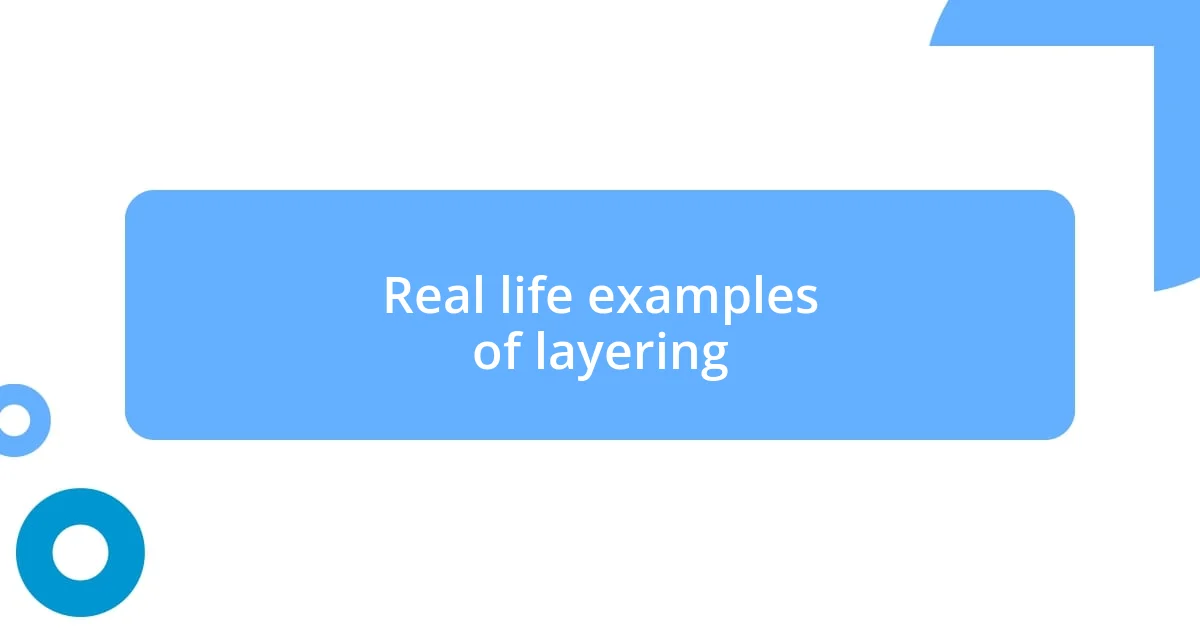Key takeaways:
- Mastering textile layering involves understanding fabric characteristics, weight, and texture to create harmonious outfits.
- Incorporating essential layering tools like scarves and belts can elevate style and functionality, ensuring a polished look.
- Avoid common mistakes such as bulky layering and poor silhouette balance by being mindful of proportions and color coordination.

Understanding layering textiles
When I first started experimenting with layering textiles, I found it fascinating how different fabrics could complement one another. I remember vividly one chilly autumn day, when I playfully layered a chunky knit sweater over a silky blouse. The contrast created not only warmth but also an unexpected texture that sparked curiosity from my friends. Have you ever noticed how layering can transform an outfit from simple to striking?
Understanding layering isn’t just about throwing on clothes; it’s about creating depth and dimension in your look. The interplay between textures—like the smoothness of silk and the ruggedness of denim—creates a conversation in your outfit. It’s an art form I’ve come to appreciate deeply, recognizing how layering can evoke different moods and adapt to various occasions.
I’ve learned that the weight, texture, and drape of each textile matter significantly. For instance, I once paired a lightweight cotton tank with a heavier wool cardigan, only to realize that the combination felt off-balance. I adjusted by adding a mid-weight scarf, which not only brought cohesion but also comfort. Isn’t it amazing how a little adjustment can elevate your ensemble?

Choosing the right textiles
When it comes to choosing the right textiles, I’ve found that understanding the characteristics of each fabric is crucial. For example, when I stumbled upon a beautiful linen fabric, I was initially drawn in by its airy feel. Yet, I quickly learned that while linen is fantastic for breathability, it wrinkles easily—an important consideration when planning my outfits for a busy day. Have you ever felt frustrated by an outfit you loved, but it just didn’t hold up through the day?
Another key factor for me has been color and pattern coordination among textiles. I recall a specific event where I tried to combine bold floral prints with a sophisticated checked pattern. The result? A chaotic look that didn’t resonate with my style. After experimenting, I’ve learned that balancing prints—like pairing a vibrant piece with a neutral—can help maintain harmony. How often do you find that striking the right balance can make or break an outfit?
The weight of the fabric significantly impacts how layers interact. I remember layering a sheer organza over a cozy cashmere sweater, thinking it would add elegance. Surprisingly, the sheer fabric created an awkward silhouette. I soon discovered that pairing lighter fabrics with similarly weighted textiles forms a seamless flow rather than a confusing clash. Have you encountered any layering blunders that led to unexpected discoveries?
| Textile | Characteristics |
|---|---|
| Linen | Breathable but wrinkles easily |
| Cotton | Durable, soft, and versatile |
| Silk | Luxurious with a smooth texture |
| Wool | Warm and insulating, but can be itchy |
| Denim | Rugged and durable, great for casual layers |
| Organza | Light and sheer, can add elegance but tricky to layer |

Essential tools for layering
The right tools can make a world of difference when it comes to mastering the art of layering textiles. I’ve discovered that having a good selection of layering essentials enhances both functionality and style. For instance, a versatile belt can cinch layers together, creating a tailored silhouette that feels polished. In a recent outing, I paired a loose outer jacket with a fitted turtleneck, using a statement belt to pull the entire look together. It transformed what could have been a frumpy ensemble into something chic and put-together.
Essential tools for layering:
- Scarves: They add warmth and style, plus they can transform the vibe of an outfit instantly.
- Belt: Perfect for creating shape and emphasizing the waist, while elevating any layered look.
- Different lengths: This includes cardigans, tunics, and cropped jackets which help create depth.
- Tights and leggings: A smart way to add warmth under dresses or shirts without adding bulk.
- Safety pins or fashion tape: These can save the day, whether it’s for adjusting a loose fit or securing a layering piece.
Each of these tools has played a role in my layering journey. I particularly remember a day when I used a lightweight scarf as a top layer. It not only complemented my outfit aesthetically but provided just enough warmth that day. It’s small modifications like this that can greatly enhance our overall appearance and comfort.

Techniques for effective layering
One of the most effective techniques for layering is to think in terms of textures. I often experiment with different fabric types to create visual intrigue. For example, once I combined a chunky knit sweater with a sleek silk shirt underneath. The contrast not only felt great against my skin, but it also added depth to my overall look. Have you ever tried mixing textures? You might be surprised by how much more interesting your outfits become.
Another technique I’ve found invaluable is to play with lengths. I remember layering a longer cardigan over a cropped top just for fun, and it turned out to be one of my favorite outfits. The longer layer created an elongating effect that made me feel taller and more confident. Isn’t it fascinating how a simple adjustment in length can change your whole perspective on an outfit? Those small tweaks often have a big impact.
Finally, don’t underestimate the power of color blocking. Perhaps one of my best layering experiences came from combining two bold hues: a vibrant red blouse under a cobalt blue jacket. Initially, I was hesitant, thinking it might clash, but the result was striking. I felt full of energy, and the confidence boost was undeniable. When have you taken a risk with colors in your wardrobe, only to find it paid off beautifully? Embracing these techniques truly transforms how we approach our style!

Stylistic considerations for layers
Styling layers is not just about functionality; it’s an art form that reflects personal expression. When I layer, I often think about harmony—how the pieces interact and complement each other. Just the other day, I threw a vibrant oversized shirt over a basic tee, and the clash of sizes created a playful vibe that simply made me smile. Have you ever noticed how certain combinations can elevate your mood? It’s as if the outfit takes on a personality of its own.
One essential stylistic consideration is the balance of proportions. I remember wearing a long, flowing duster coat over a fitted dress. The contrast not only made the outfit visually striking but also felt empowering. It’s that sensation of confidence when our choices resonate with who we are that keeps me experimenting. Have you found that right balance in your layers, where one piece just makes everything click?
Texture also plays a pivotal role in layering that often goes overlooked. I once paired a delicate lace blouse with a textured wool cardigan, and the results were breathtaking. The interplay of the soft lace against the cozy knit felt like a warm embrace, both visually and emotionally. It’s incredible how certain fabrics can evoke feelings and enhance our experiences. What textures bring you comfort and joy when layered together?

Common mistakes to avoid
One common mistake I often see is layering too many bulky pieces. It can easily lead to a look that’s more cumbersome than chic. I remember a day when I tried to layer a thick sweater with a puffer vest and ended up feeling like a walking marshmallow. Have you ever worn something that made you feel weighed down instead of stylish? Streamlining your layers can create that effortlessly cool vibe we all want.
Another pitfall is forgetting to consider the overall silhouette. I once layered a boxy jacket over a voluminous dress, thinking it would create a fun contrast. Instead, I felt lost in fabric, and my shape disappeared. Have you ever chosen layers that made you look larger than you intended? Being mindful of how each piece contributes to your overall shape can help you achieve a flattering outcome.
Color clashes can also derail a great layered look. I remember putting together an outfit with several colors without thinking about how they would work together. The result was a chaotic mix that left me feeling unsettled. Have you ever experienced that moment in front of the mirror when something just doesn’t sit right? Picking a cohesive color palette for your layers not only enhances visual appeal but also boosts your confidence when you step out.

Real life examples of layering
When it comes to real-life layering, I often revisit an outfit I wore last spring that highlights how textures and styles can collide beautifully. I paired a leather bomber jacket with a floral mid-length skirt and ankle boots. The unexpected mix felt audacious yet grounded, as the edgy leather contrasted perfectly with the soft petals of the skirt. Have you ever experienced that thrilling moment when an outfit feels both daring and comfortable?
On another occasion, I decided to layer a chunky knit tunic over a sleek turtleneck dress for a cozy dinner out. The two silhouettes complemented each other so nicely that I felt like I could tackle anything that night. Each layer added warmth while still being chic. It made me wonder if there are those combinations in your wardrobe that give you that special sense of confidence.
I also recall a chilly weekend when I effortlessly layered a denim jacket over a hoodie, finishing the look with a lightweight scarf. This combination not only kept me warm but also injected a sense of casual flair into my outfit. It’s funny how the simplest layers can come together to create a perfect balance. What are the go-to pieces you rely on to bring your layered looks to life?













